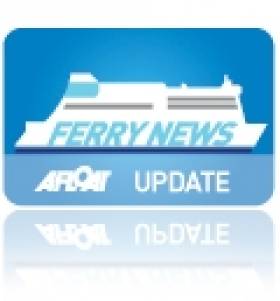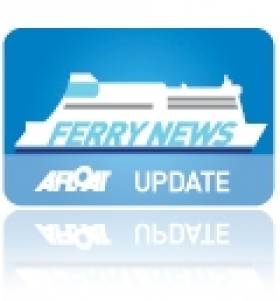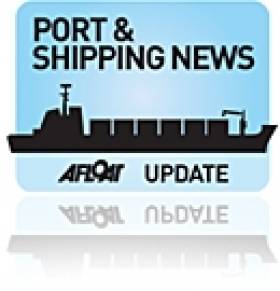Displaying items by tag: HSS Stena Explorer
Countdown to the Return of the HSS
#FERRY NEWS-A month from today sees the resumption of fast-ferry sailings on the Dun Laoghaire-Holyhead route, operated by Stena Line's HSS Stena Explorer, writes Jehan Ashmore.
The 120 minute central-corridor route closed in mid-September due to consistent high operating costs in recent years. This led to the withdrawal of the fuel-thirsty HSS craft which is powered by four gas-turbine engines.
In addition most of the route's turnover was generated in the high season months, leaving the remaining months unsustainable. As such the company decided to make the service as a seasonal-only operation. To read a previous report of the closure click HERE.
The ending of the year-round-service was the first major break to the route since the introduction of the pioneering HSS Stena Explorer in 1996 which in turn had replaced conventional tonnage. The Finnish built craft was the first of a trio of sisters commissioned for Stena Line and only this vessel remains in service for the operator.
Also operating on the route in recent years was the smaller fast-ferry craft Stena Lynx III which had served several high and low seasons, though she will not be joining her larger fleetmate. The Tasmanian built Incat fastcraft was sold last year to South Korean interests as previously reported on Afloat. ie
Meanwhile the company's Dublin-Holyhead route is maintained by conventional tonnage vessels, Stena Adventurer and Stena Nordica which operate the 3 hour 15 minute service.
Farewell as Stena Line’s ‘Lynx’ Fast-Ferry Sets Sail for South Korea
Sunflower 2 is to make bunker calls on the repositioning voyage, firstly in Valletta, Malta before she transits the Suez Canal to the Red Sea port of Jeddah, Saudi Arabia and Columbo, Sri Lanka. From there she transits the Strait of Malacca then through the South China Sea followed by the East China Sea before finally entering the Strait of Korea to her homeport of Busan.
Since 1999 she has served Stena Line's fast-ferry high-season Rosslare-Fishguard route sailings taking 1 hour 50 minutes in tandem with conventional ferry Stena Europe (1981/24,828grt) which currently maintains the year-round 3 hours 30 minutes route. It is believed that Stena Line will not be operating high-season fast-ferry services in 2012.
Prior to her Dun Laoghaire departure, her South Korean crew have been preparing the craft over the last three weeks. Notably there was the removal of all Stena Line corporate livery markings on the hull. Her new name and port of registry were painted at the stern though she retained her original name at the bow which included both symbols of an Irish shamrock aptly to starboard (green) and the Welsh dragon to port (red) to reflect her Irish Sea southern corridor route.
Stena Lynx III departing Dun Laoghaire last year, note her starboard 'Shamrock' at the bow.
In recent years on the St. Georges Channel route she was marketed as the Stena 'Express'. Her final sailing this year was 4 September and three days later she docked Dun Laoghaire at St. Michaels Pier. On the adjacent berth which is designed specifically for and only capable of accommodating the HSS 1500 class fast-ferries.
Stena Lynx III also ran several shoulder season stints on the Dun Laoghaire-Holyhead route with the HSS Stena Explorer (1996/19,638grt) only running during the busier summer months. During this summer all sailings were maintained by HSS Stena Explorer until the route became a seasonal-only service for the first time this year when the last sailing took place in mid-September. The HSS remains in layover for the winter in Holyhead at her dedicated berth. The route is due to re-open in April or May.
The 35 knot Stena Lynx III was launched from fast-ferry catamaran specialists InCAT Pty based in the Tasmanian capital of Hobart. Early in her career the 81m wave-piercing catamaran (WPC) craft served Dover-Calais followed by two seasons between Newhaven-Dieppe when renamed P&O Elite for joint operators P&O Stena Line.
Her predecessors the WPC InCat 74m Stena Sea Lynx, became the first car-carrying catamaran to operate Dun Laoghaire-Holyhead sailings in 1993. The pioneering water-jet propelled craft was replaced in subsequent years by the larger InCAT 78m Stena Lynx II.
She was replaced in 1996 when the revolutionary four gas-turbine engine water-jet propelled HSS Stena Explorer was introduced. A further two sisters of the HSS 1500 class (High-speed Sea Service) were completed by Finnyards in Rauma.
- Dublin Port
- Dublin Bay News
- HSS Stena Explorer
- Dun LaoghaireHolyhead
- Stena Lynx III
- Ports and Shipping
- Dun Laoghaire Harbour
- Stena Line
- Ports and Shipping News
- Ferry news
- DoverCalais
- HSS
- RosslareFishguard
- Stena Express
- InCat
- Finnyards
- Dun Laoghaire Harbour News
- Irish Sea fastferries
- Sunflower 2
- P&O Elite
- Highspeed Sea Service
- St.Michaels Pier Dun Laoghaire
Dun Laoghaire-Holyhead (HSS) High Speed Sailings Close
The core reason to withdraw the HSS on the 120-minute route which is not to re-open until the 2012 season, rests with the high operating costs of the fuel-thirsty fast-ferry which is powered by four gas-turbine engines. In addition the route's generated most of its turnover during the period May-September, leaving the remaining months unsustainable, as such the company wants the route to be seasonal-only in the long-term.

HSS Stena Explorer departs Dun Laoghaire Harbour on her final sailing this season. Photo: Jehan Ashmore
Passengers and freight customers will instead need to use the company's other Dublin Bay route between Dublin Port and Holyhead. The 3 hour 15-minute central corridor route is served by two ro-pax vessels, Stena Adventurer (2004/43,532 grt) and Stena Nordica (2000/24,206 grt) which operate to a year-round schedule, for times click HERE.
What is not certain is the precise date for resumption of Dun Laoghaire-Holyhead services as Stena Line have only indicated that they hope to reopen in April or May nor it is outlined as to what type of fast-craft would operate the route next year.
With today's break in service for at least the next six months, this is the most significant absence of the revolutionary HSS (High Speed Sea Service) 1500 fast-ferry which made her official maiden voyage on the route from Dun Laoghaire on 10th April 1996. The only other notable occasions when the HSS was off-service was for the short spells to allow for annual dry-docking, refit, repairs or when the route in recent years was partially operated by Stena Lynx III.
The 1500 referred to the number of passengers the Stena Explorer could accommodate. She was the first of the three Finish-built HSS 1500 catamaran vehicle capable carrying craft to enter service on three routes from the UK. The next sister completed HSS Stena Discovery entered service in the same year between Harwich-Hook van Holland and the final of the trio HSS Stena Voyager entered the Belfast-Stranraer route in 1997. Several years ago the HSS ceased operating on the Dutch route and the HSS currently serving on the North Channel is due to be replaced by conventional ferries in mid-November as previously reported on Afloat.ie, to read more click HERE.
On the Dun Laoghaire-Holyhead service the HSS enjoyed the boom years, and at its peak there were five daily round trips. From 2006 onwards the routes fortunes began to decline due to the ending of duty-free sales, competition from low-cost airlines, and the increasing cost of fuel.
In order to stave off further losses, a series of cost cutting measures were implemented over the next five years. Firstly the sailing frequency was reduced then the passage times were increased to reduce fuel consumption at the expense of faster crossings. In addition the company resorted to withdrawing the Stena Explorer during the shoulder months surrounding the summer and as previously mentioned these sailings were covered by the Stena Lynx III.
When the Stena Explorer returned for the summer months, the Stena Lynx III switched to her normal high-season spell on Rosslare-Fishguard sailings in tandem with regular route vessel Stena Europe. This year she served as usual on the St. Georges Channel route with the last high-season sailing completed on 4 September.
Stena Lynx III remained initially at Fishguard until making a repositioning voyage to Dun Laoghaire via the Kish Lighthouse last Wednesday. She berthed adjacent to the now disused HSS berth link-span on St. Michaels Wharf. The Tasmanian built craft has spent previous winter layover periods in Dublin and last year in Dun Laoghaire whereas the Stena Explorer is expected to do so in her home port of Holyhead.
At the neighbouring Carlisle Pier, the former terminal where numerous steam-packets, 'mailboats' and the conventional Sealink/British Rail car-ferries served (the last being the Stena Adventurer better known as St. Columba built in 1977) there are plans for a national diaspora museum.
The centrepiece landmark building would form as part of the masterplan proposed by the Dun Laoghaire Harbour Company as part of a concerted effort to offset the reduced role of ferry operations. The masterplan is also to attract cruiseship business amongst other proposals envisaged.
- Dublin Port
- Dun Laoghaire Harbour Company
- Cruise Liners
- HSS Stena Explorer
- Dun LaoghaireHolyhead
- Stena Lynx III
- Stena Line
- Port of Dublin
- Ports and Shipping News
- Ferry news
- Stena Explorer
- HSS
- St.Michaels Wharf
- Dun Laoghaire Harbour News
- Stena Adventurer
- Irish Sea ferry news
- Cruise ships
- Carlisle Pier Dun Laoghaire
- Stena Nordica
- Closure of HSS sailings
- HSS (High Speed Sea Service)
- Dun Laoghaire masterplan
- Diaspora Museum Dun Laoghaire
Stena Line to Reduce Dun Laoghaire-Holyhead Service
Stena Line said the fast craft service would operate until 13th September and would then be suspended until the 2012 season. Two conventional ferries will continue to operate year-round on the company's neighbouring route between Dublin Port and Holyhead.
Stena said it hoped to start the service again in April or May although no decision has been made on an exact date.
Area Director for Stena Line's business on the Irish Sea Michael McGrath said: "Despite all our attempts to reduce operating costs over the last few years, it has not been possible to return the route to profitability.
"We regret that this decision will have an impact amongst our ship's personnel and our port operations staff in Dun Laoghaire but this is a decision that has to be taken for the benefit of the overall business. We simply cannot continue to sustain these levels of financial losses.
"We will now embark on a period of consultation with our staff and their union representatives to discuss the implications of the proposed changes with them."
Stena says it hope to start the service again in April or May, although no decision has been made on an exact date. It is believed around 53 staff will be affected by the decision.
The 'Lynx' Returns to Dun Laoghaire
on the Dun Laoghaire-Holyhead route, writes Jehan Ashmore.
ferry Stena Europe on the Rosslare-Fishguard route. Prior to then the Lynx craft also served Spring
sailings on the Dun Laoghaire-Holyhead service as a replacement vessel of the HSS Stena Explorer.
The reasoning for the change of vessels on the central Irish Sea route during the Spring and
forthcoming Autumn /Winter seasons is a cost-cutting measure on behalf of operators Stena Line.
The larger HSS craft is becoming increasingly more expensive to run using fuel thirsty gas-
turbine engines, compared to the smaller capacity Stena Lynx III, which can be used instead
during the quieter months.
Stena Explorer is to be withdrawn with the last round trip sailing tomorrow (14 September)
departing Holyhead at 10.00hrs and arriving at Dun Laoghaire at noon. Correspondingly the HSS departs
the Irish port at 13.15hrs and returns to the Welsh port two hours later.
On the following day (15 September) the Stena Lynx III will make her first outbound departure
from Holyhead at 10.00hrs arriving Dun Laoghaire at 11.50hrs. After a turn-around period in the Irish port
the Lynx departs at 13.15hrs with an arrival to the Anglesey port at 15.05hrs.




























































